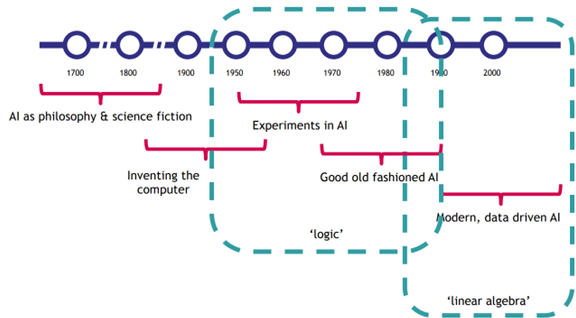It is 2024, ChatGPT, the world-famous chatbot, had its first birthday last October, and Artificial Intelligence, or AI in short, is all the hype. In the past year, AI has risen to the mystical status of God. While their exact workings remain elusive to the public, adoption of AI systems has skyrocketed. ChatGPT, probably the hottest thing right now amassed a whopping one million users in its first week! This enthusiasm, however, is accompanied by a healthy dose of existential fear, with no other than ChatGPT’s CEO at OpenAI, Sam Altman even warning of “the risk of extinction from AI”. Regardless of your attitude towards the ‘sudden’ rise of AI, its prominence cannot be denied. But what is AI? Where does it come from? What can it do? And perhaps more importantly, what do we want it to do?
The early days
AI has come a long way since its conception in the mid-20th century. The journey began in the 1950s with Alan Turing’s “Intelligent Machinery” report, which laid the groundwork for a logic/rule-based approach to problem-solving, more commonly known as ‘classical AI’. This approach birthed a range of expert systems and computer programs that used expertise and knowledge to emulate the decision-making of human professionals. Expert systems are currently still being employed, for example in clinical settings, to help clinicians with diagnosing patients. These systems, however, are not what the current AI hype is about.
Machine learning and more specifically, deep learning is currently all the hype. It’s the technology behind ChatGPT. Machine learning first developed in the 1960s- and 70s and uses mathematics, more specifically linear algebra, and statistics to infer information based on large data sets. Deep learning neural networks, which were designed to replicate the brain’s neural structure, were developed in the 1990s. Deep learning excels at picking up on regularities and patterns within vast datasets and using these patterns to make accurate predictions and inferences.
AI Boom
It has been a while since the first conceptions of machine learning algorithms. How come we are only experiencing this AI boom right now? To find the answer to this question we should look at the rise of big data and microchip makers, rather than AI researchers. The current AI boom we are experiencing is a consequence of a perfect storm of data abundance paired with significant increases in computing power. The algorithms haven’t necessarily gotten much smarter, so to say. Some of the mystery surrounding AI’s workings doesn’t primarily stem from the use of complex algorithms but, rather, from how deep learning models, arrive at their outputs based on their training data. With very big data sets, it can be hard to understand what information from the training data was used to come to an output.

A simple timeline of AI, Image credit: Dr. Sieuwert van Otterloo
Hi there
AI is here and it is here to stay. An online survey of 600 American business owners, found that almost all (97%) business owners believe ChatGPT will help their business [1]. In another survey 89% of students admitted to using ChatGPT for their schoolwork [2]. It’s perhaps not surprising since ChatGPT has demonstrated its capabilities by achieving high scores on various exams, including the SAT and the bar exam, where it ranked in the top 10 for both [3]. A study investigating the effectiveness of AI chatbots as healthcare providers reported chatbots providing more empathetic and accurate responses than doctors when answering questions on a medical forum [4]. This is all very impressive. Still, a lot of people are very concerned about AI. These concerns extend beyond the existential risk of AI potentially wiping out humanity and encompass real ongoing negative consequences associated with its development and employment.
Costly development
Let’s now briefly return to the beginning of the AI boom. Here, immediately two important remarks ought to be made. Remember the driving forces behind the AI boom? As important as big data sets and massive computing power are, they also pose significant problems.
To start with the data sets. As mentioned earlier, deep neural networks are designed to identify patterns within their training data. For instance, a training set could contain a variety of images featuring different types of vehicles. However, merely having images is not sufficient. To enable the deep neural network to accurately distinguish between various vehicle types, the dataset should be labeled. This means providing descriptions for each image, specifying what is depicted in them. These incredible amounts of data sets are being labeled by so-called ‘ghost workers’. The issue is, the outrageously low amount of pay these people receive for their work, with hourly salaries sometimes being as low as $0.26 [5]. This raises important ethical concerns around fair labor practices and the need for equitable compensation for their contribution to the development of AI technologies.
Continuing with the second element essential for the AI boom is computing power. The microchips necessary for large deep neural networks such as the one powering ChatGPT use enormous amounts of energy. If current trends in AI capacity and adoption continue, then in 2027 NVIDIA will be shipping 1.5 million AI server units per year, consuming respectively at least 85.4 terawatt-hours of electricity annually [6], this is more than what many small countries use in a year, according to the new assessment. These servers will be in big data centers, which become extremely hot, subsequently requiring a lot of fresh drinking water for cooling. The training of OpenAI’s GPT-3 model used a staggering 700.000 liters of water and asking between 20 and 50 questions costs an additional 0.5 liter of water [7]. Given the current state of the planet, we must make sure companies are incentivized to operate as energy efficiently as possible.
Discriminating algorithms
The problems do not limit themselves to the development of AI. Also, in their use things can seriously go wrong. A heartbreaking example of how in the period between 2004 and 2019 approximately 26.000 parents and 70.000 children fell victim to faulty algorithmic decisions, is the Toeslagenschandaal [8]. These families were receiving childcare allowance, but at some moment in time they got notified that they did not have the right to the allowance and had to immediately pay back huge amounts of money, many families got into financial trouble because of this. Amnesty International concluded that the algorithm used by the Dutch tax authority violated human rights [9]. The algorithm used a ‘risk model’ for checking the childcare allowance applications, this model considered multiple different factors, one of which is not having a Dutch nationality. Due to algorithmic discrimination by their government, these parents and children were forced to endure an immensely stressful and devastating period. The damage done to these people can not be undone. This truly sad moment in history is a very strong warning of what can go wrong when using algorithms to make life-impacting decisions.
Where the discrimination done by the algorithm from the Toeslagenschandaal was intended, with a lot of other algorithms it happens unintentionally. Facial recognition systems, for example, have a lot more trouble identifying black faces than white faces [10]. And Amazon had to ditch its AI recruiting engine because it discriminated against women [11]. These unintended effects are often the result of biased data used for the training of these algorithms. These biased data sets might reflect human biases, for example, a bias against men of African American descent in American police databases. These biased data sets and resulting discriminating algorithms are problematic. What can be even more problematic is when we start putting too much, unwarranted, faith in algorithms. Creating an illusion of equality and fairness, when in reality, human biases that we try our best to combat, continue to be perpetuated.
To conclude, AI is a very promising technology with a lot of potential. It will be very exciting to witness the further development of AI. Who knows what will be possible in a couple of years from now? That being said, I also do believe that AI has some serious issues, such as unfair labor practices, sustainability, and algorithmic discrimination. Therefore, it is of the utmost importance that we engage in thoughtful and in-depth discussions about the precise role we want AI to play in our lives and how we can harness its potential while effectively mitigating its associated risks. This cannot wait.
[1] Haan, Katherine. “How Businesses Are Using Artificial Intelligence in 2024.” Forbes Advisor, April 24, 2023. https://www.forbes.com/advisor/business/software/ai-in-business/. [2] Westfall, Chris. “Educators Battle Plagiarism as 89% of Students Admit to Using OpenAI’s ChatGPT for Homework.” Forbes, January 28, 2023. https://www.forbes.com/sites/chriswestfall/2023/01/28/educators-battle-plagiarism-as-89-of-students-admit-to-using-open-ais-chatgpt-for-homework/. [3] “ChatGPT-4,” OpenAI. https://cdn.openai.com/papers/gpt-4.pdf. [4] Korteweg, Niki. “ChatGPT verslaat artsen bij het geven van antwoord op medische vragen.” NRC, May 2, 2023. https://www.nrc.nl/nieuws/2023/05/02/chatgpt-verslaat-artsen-bij-het-geven-van-antwoord-op-medische-vragen-a4163538. [5] Rowe, Niamh. “Underage Workers Are Training AI.” WIRED, November 15, 2023. https://www.wired.com/story/artificial-intelligence-data-labeling-children/. [6] De Vries, Alex. “The Growing Energy Footprint of Artificial Intelligence.” Joule 7, no. 10 (October 1, 2023): 2191–94. https://doi.org/10.1016/j.joule.2023.09.004. [7] “The Secret Water Footprint of AI Technology – the Markup,” April 15, 2023. https://themarkup.org/hello-world/2023/04/15/the-secret-water-footprint-of-ai-technology. [8] Wikipedia-bijdragers. “Toeslagenaffaire.” Wikipedia, January 22, 2024. https://nl.wikipedia.org/wiki/Toeslagenaffaire. [9] NU.nl. “Fiscus gebruikte in toeslagenaffaire algoritmes die mensenrechten schenden.” NU.nl, October 26, 2021. https://www.nu.nl/tech/6164117/fiscus-gebruikte-in-toeslagenaffaire-algoritmes-die-mensenrechten-schenden.html. [10] Simonite, Tom. “The Best Algorithms Still Struggle to Recognize Black Faces.” WIRED, July 22, 2019. https://www.wired.com/story/best-algorithms-struggle-recognize-black-faces-equally/. [11] Reporter, Guardian Staff. “Amazon Ditched AI Recruiting Tool That Favored Men for Technical Jobs.” The Guardian, October 11, 2018. https://www.theguardian.com/technology/2018/oct/10/amazon-hiring-ai-gender-bias-recruiting-engine.